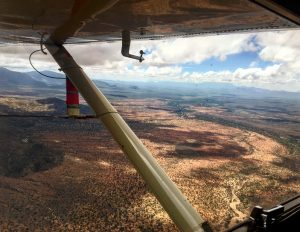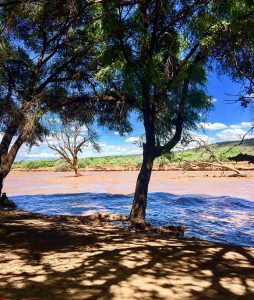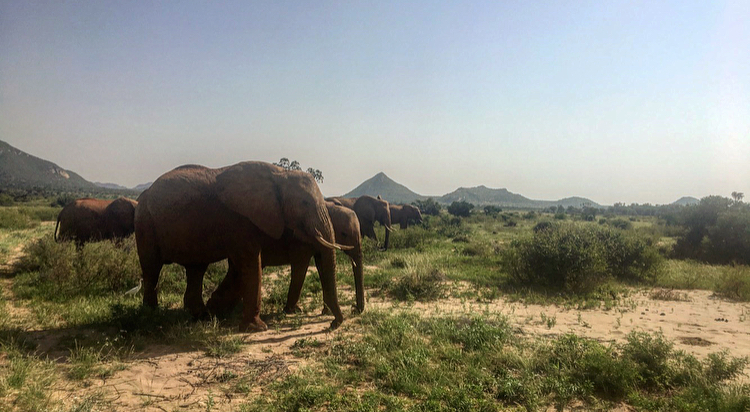My Return to Kenya
Hello, I’m Ellie Sutton. I was born and raised in Scotland and I’m proud of it! But, in truth part of my heart will always lie in Kenya. I’m here now for the third time, re-living fond memories from my childhood thanks to an amazing internship at Elephant Watch Camp.

It was all a bit last minute – being called upon to come to Samburu – but that was part of the adventure! With unpredictable weather between Nairobi and Mt Kenya, I was whisked off a day early on a diversion to Naivasha in the Save The Elephants Cessna 185 with Iain Douglas-Hamilton. Safe to say, it was the smallest plane I have ever boarded but by far the most thrilling! One can only truly witness the vast scale and beauty of the Kenyan landscape from the sky, painting a mountainous spectacle as far as the eye can see. It was at this moment, gazing across the never-ending horizon, that I realised I’d embarked on a once in a lifetime journey of which I could only dream.
A Warm Welcome
This was my first time visiting Samburu, so I was unsure what to expect and how it would compare to elsewhere in Kenya. On my arrival, there was something about the people that made me feel completely at home. Wide smiles, reassuring and joyful, made me relax at once. But I was taken by surprise by all the tartan! Tall warriors cloaked in red Hamilton, flung with careless panache across their bead-adorned chests. There are lots of local variations too, and I’ve come to learn tartan is the most popular form of dress among the Samburu, paired with traditional beaded garments and other brightly coloured materials. The unique marriage between Scottish and Samburu culture is spectacular, and I dare say the tartan is worn better here than back home!

Saba and Frank welcomed me into their home as if I had been here for a lifetime. I’d seen pictures and clips of the Camp both online and on television, but even this did not prepare me for it’s beauty. Situated on the banks of the Ewaso Nyiro river and hidden in a forest of graceful Acacia trees, the Camp is unique. Each tent combines stylish elephant-themes with traditional African patterns, utterly luxurious to the mind’s eye but as simple and eco-conscious as it gets. I was even told elephants wander right through the Camp, both day and night, occasionally rubbing their derrieres on the rough-barked trees by the tents! I couldn’t imagine it until I saw it with own eyes.
Here you get closer to nature than ever imaginable. One of the aspects I really love about the Camp is it’s fierce commitment to sustainability. In a world where climate change and global warming are of increasing concern, we need radical change everywhere. Even the smallest changes can make a difference. Water is precious here in Samburu’s semi desert, so waste is minimised by having a self-operating bucket-shower and tap. The furnishings are beautifully hand-crafted, materials locally sourced, and all made by the nomads that live here. Hopefully this is one of the many reasons guests come to Elephant Watch Camp; to embrace nature whilst having zero impact on it.
The Rainy Season
The rains in Samburu arrived much later than anticipated this year. The wet season normally begins in April, but the first rains didn’t fall until June. There was much celebration as the bare earth transformed into a lush green ecosystem hosting an array of delighted herbivores. And just as the animals require water to drink, the soil too was in need of a good soaking for the first fragile grass shoots to poke their heads above ground. Most exciting of all was watching the elephants come back together in big herds, enjoying the rush of fresh water in the way that only elephants can.
As storms come and go, the river responds by roaring past or falling into a gentle hush, the breeze in its wake kissing one’s skin. Coming from a country where rain is a given most days and normally not welcome, I have learnt to appreciate just how important it is here. I now realise that so many of us take water for granted, and I’m ashamed to realise how many precious resources we waste in our throwaway culture. Here in Kenya, even plastic bags are considered to be valuable now, thanks to a national ban on single use plastics.

I think this is one of the best times of year to visit Samburu as there is a perfect contrast between the hot midday sun and the cooler evenings. With all the elephants pouring back into the reserves, thanks to the rain, I’ve learnt that each family is named after a category and the guides know every single elephant by name. This makes watching elephants so much more interesting, as not only are they enjoying the social aspects of the rainy season by gathering in great herds, but you soon get to know them as individuals, each with their own particular likes and dislikes, triumphs and tragedies, all of which have been recorded in great detail by Save the Elephants researchers since 1997.
A Day in the Camp
Every day is different here in Samburu, and that’s what I love about it. I’ve been trying to learn Swahili, and even some Samburu, with the help of the very patient staff! Best of all is that you never know what kind of wildlife you will see in camp, from vervet monkeys swinging happily in the trees to small scorpions hiding in the dark. I’ve discovered something new every day, and am becoming increasingly interested in all the different species. Point is, you don’t need to be only an elephant lover to stay here!
There is so little light pollution, just a few hurricane lamps at dinner, that you can see the Milky Way in all its glory. And under this extensive star-scape, we have the most fascinating conversations a mealtimes, with some of the amazing people that come to stay here – the CEOs of conservation funds, visitors from all around the world that share a passion for the natural world, or the field researchers from Save the Elephants. Of course – as an environmental science student – this is a rare opportunity to learn skills and absorb knowledge that I know I’ll use for the rest of my life. Helping organise meetings for the local stakeholders of the Ewaso ecosystem, finishing off a project proposal for a mobile clinic, and refining the Camp’s social media output are just some of the many things I’ve been tasked with. It’s given me such an interesting insight into the challenges the people face here on a day to day basis.
Looking Forward
Securing a future for elephants by winning the battle against ivory trade and protecting their habitat, is being pushed forward by the amazing team here and at Save the Elephants. But what I’ve come to understand deep in my heart is that change must be catalysed by all of us. Lawyers, vets, teachers, financiers and journalists, every one of us can do our bit to protect the environment and increase biodiversity. I was told something that really made me think…anyone who has a passion for conservation and animals is a conservationist and can contribute to saving our biosphere. It is so easy for us to say that we can only achieve certain things if we are trained professionals in that specific area. But it’s not true! We can change the world as individuals by taking small steps every day in our own back yards, whether we’re a 16 year old climate activist like Greta Thunberg, a concerned participant in Extinction Rebellion, or simply by choosing to waste less and re-use more.

Saba’s daughter, Luna, watching a herd of stallion Grevy’s zebra.
I see it as a domino effect; – change coming in countless different forms from all angles – inspiring others to do the same and awakening them to urgent issues affecting us and every other species on Earth. Elephant Watch Camp provides a haven for the conscious traveller seeking to experience authentic Africa, as well as a launch pad where the people that share the same love and dedication for wildlife can congregate, expand their knowledge, and join hands with the alliance fighting for Nature.

